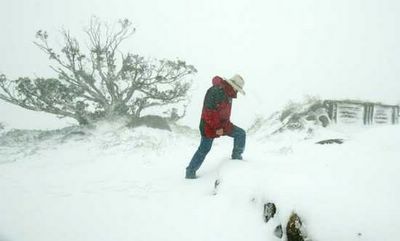
Photo: Chris Lane

Visitors in February to Charlotte Pass ski resort could normally expect to go hiking on the grassy mountain slopes and enjoy a drink afterwards on their chalet balcony in the sun.
But yesterday, people had to huddle inside to avoid the blizzards and freezing temperatures.
Manager of the Stillwell Lodge, Stephen Young, said visibility was low, driving was hazardous and the village roads were covered in 15 centimetres of snow. "You wouldn't want to go out there now for a cocktail," he said.
The unusual weather that turned summer into winter in eastern Australia also had meteorologists gasping, with some describing it as among the most extraordinary they had witnessed.
Melbourne was under water after experiencing the heaviest rainfall in 24 hours since records began in 1856. Huge waves in Bass Strait smashed windows on a ferry on its way to Tasmania. And the cold snap across NSW saw February records for minimum overnight temperatures broken in many country towns.
In Sydney, almost all the damage to property was caused by heavy rain and wind, which felled trees and lifted roofs. Around Gosford the damage was caused by hail, smashing skylights and tiles.
"Same day, same weather, and yet we've got something quite dramatically different not that far apart," a State Emergency Service spokesman said.
A senior forecaster at the Bureau of Meteorology, Elly Spark, said the cause of the havoc, a low-pressure system that developed late on Wednesday to the east of Bass Strait, was extremely intense, equivalent to a tropical cyclone.
"It intensified very rapidly and has been bringing horrendous winds and snow. You have a winter-type situation in the middle of February."
Winds in excess of 100kmh buffeted the Snowy Mountains with gusts more than 120kmh.
While February snowfalls in the Victorian ski resorts were not unheard of, dumps of 12centimetres were unusual, Ms Spark said. "It's an amazing situation."
The bureau's climate technical officer, Mike De Salis, said the low was also unusual in that it moved westward, rather than out to sea, so it ended up right on top of Melbourne. "It deepened as it went, picking up moisture from Bass Strait and sucking it in."
Cold air from the low pressure system caused light snow to fall yesterday on the ranges near Canberra and sleet was reported in the capital as temperatures plummeted. Snow also fell at Thredbo and Perisher ski resorts where the temperature was below minus 1.
There have only been five February snowfalls in Perisher Valley in 29 years of records, with the last in 1998, according to the Bureau of Meteorology.
A forecaster with the Bureau of Meteorology in Melbourne, Ward Rooney, said he had never seen a storm like the one that hit Melbourne.
It dumped 120 millimetres of rain in the 24 hours to 9am yesterday, causing flooding, chaos and the diversion of some flights. Melbourne's average February rainfall is 45.8 mm.
Huge seas battered the Spirit of Tasmania I ferry which had to return to Melbourne.
Judy Archer, from Melbourne, said the voyage had been terrifying. "The waves were just enormous, just enormous. I was on the bunk and I could feel my body sort of lifting up in the air and crash down again," she told reporters.
In NSW, the SES received 2750 calls for assistance in the 24 hours to 4pm yesterday, most from the Ryde, Baulkham Hills and Gosford areas and the Southern Highlands.
On the South Coast, seven children and a teacher from Ulladulla Primary School were taken to hospital with minor injuries after a tree fell on their demountable classroom.
In NSW, Hay had its coldest February day ever on Wednesday, with a maximum of 13 degrees, rather than the average of 33 degrees for this time of year. Records for minimum overnight temperatures in February were broken in many country towns such as Coonabarabran, where the mercury fell to 3.6 degrees (previous record minimum: 5.6 degrees in 1993) and Condobolin, where it was a chilly 5 degrees (previous record: 6.6 degrees in 1985).
There was also good news: dam levels in the Sydney catchment have risen 0.6 percentage points this week to 42.7 per cent. The Warragamba catchment received 70 millimetres of rain this week.